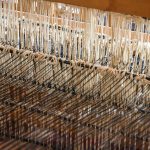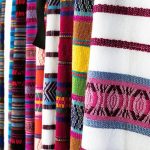Are you curious about what shantung silk fabric is? Look no further!
In this article, we will explore the origin, characteristics, types, and uses of shantung silk fabric.
You’ll learn how it is made and discover tips for caring for this luxurious material.
So, if you want to know all there is to know about shantung silk fabric, keep reading!
Table of Contents
The Origin of Shantung Silk Fabric
Shantung silk fabric originated in the Shandong province of China. It is named after the city of Shantung, which is now called Shandong. Shantung silk is a type of silk that is known for its unique texture and appearance. It is made from silk fibers that are produced by silkworms, and the fabric is woven using a special technique that creates a slightly uneven and slubby texture. This texture gives shantung silk its characteristic charm and makes it stand out from other types of silk fabrics.
The historical significance of shantung silk fabric is rooted in its association with Chinese culture and tradition. It has been used for centuries in the making of traditional Chinese clothing, such as cheongsams and qipaos. Shantung silk fabric is also highly regarded for its durability and versatility. It can be used to create a range of garments, from elegant evening wear to casual everyday attire.
Today, shantung silk fabric continues to be valued for its luxurious feel and timeless appeal. Its origins and historical significance make it a sought-after fabric in the fashion industry, both in China and around the world.
Characteristics of Shantung Silk Fabric
The characteristics of Shantung silk fabric include its unique texture and sheen. It is a luxurious fabric that is known for its crisp and slightly rough surface, giving it a distinct tactile feel. The sheen of Shantung silk is subtle yet elegant, adding a touch of sophistication to any garment or home decor item.
Here are three reasons why Shantung silk fabric will evoke emotion in you:
-
Elegance: The weaving techniques used to create Shantung silk result in a fabric that has a natural luster and a refined appearance. When you wear or use Shantung silk, you can’t help but feel a sense of grace and opulence.
-
Versatility: Shantung silk is a versatile fabric that can be used for a wide range of purposes. Whether you want to create a luxurious evening gown or add a touch of elegance to your home with curtains or upholstery, Shantung silk is the perfect choice.
-
Care Instructions: Taking care of your Shantung silk fabric is important to maintain its beauty and longevity. To keep it looking its best, it is recommended to dry clean Shantung silk to avoid any damage or shrinking.
Types of Shantung Silk Fabric
In this discussion, we’ll explore the different types of Shantung silk fabric.
Firstly, let’s delve into the various weave patterns that can be found in Shantung silk. These include plain, slub, and jacquard weaves.
Next, we’ll examine the wide range of color variations available in Shantung silk. You’ll find everything from vibrant and bold hues to more subtle and muted tones.
Weave Patterns of Shantung
Shantung silk fabric has unique weave patterns that create a textured and luxurious appearance. The most common weave pattern used in shantung silk is called the plain weave. This pattern consists of a simple over-under weaving technique, resulting in a smooth and even fabric.
Another popular weave pattern is the twill weave, which has a diagonal ribbed texture. This adds depth and dimension to the fabric, making it more visually interesting.
In addition to weave patterns, shantung silk is also known for its dyeing techniques. The fabric can be dyed using various methods such as solid dyeing, where the entire fabric is dyed in one color, or tie-dyeing, which creates unique patterns by tying sections of fabric before dyeing.
These dyeing techniques further enhance the beauty and versatility of shantung silk fabric.
Color Variations in Shantung
Color variations in shantung silk are achieved through different dyeing techniques. The vibrant hues and subtle tones of shantung fabric make it a popular choice for various fashion applications.
When it comes to color trends, shantung silk offers a wide range of options. From bold and bright colors to soft pastels and earthy tones, there is something to suit every style and preference.
To maintain the vibrancy of your shantung silk garments, it is important to follow proper fabric care. Handwashing with mild detergent and cold water is recommended to avoid color fading. Avoid wringing or twisting the fabric and instead, gently squeeze out excess water.
Lay the garment flat to dry to prevent stretching or misshaping. By following these care instructions, you can ensure that your shantung silk garments retain their beautiful colors for years to come.
Common Applications for Shantung
When considering common applications for shantung, you’ll find that this versatile material can be used for a variety of fashion and home decor projects.
In the world of fashion, shantung silk is often used to create elegant evening gowns, cocktail dresses, and blouses. Its crisp texture adds a touch of sophistication to any outfit. Shantung is also a popular choice for men’s suits and ties, adding a refined and luxurious feel.
In terms of home decor, shantung is commonly used for curtains, drapes, and upholstery. Its natural sheen and durability make it ideal for adding a touch of elegance to any room.
When it comes to caring for shantung, it is important to follow the care instructions provided by the manufacturer. Generally, dry cleaning is recommended to maintain the fabric’s texture and quality.
How Shantung Silk Fabric Is Made
In this section, we’ll discuss the weaving process of shantung silk fabric and the dyeing techniques used. You’ll learn about the intricate steps involved in weaving this fabric, from the selection of the silk threads to the final product.
We’ll also explore the various dyeing techniques employed to create the vibrant and rich colors that shantung silk is known for.
Weaving Process Discussion
You can learn about the weaving process of shantung silk fabric. Shantung silk is a luxurious fabric known for its unique texture and lustrous appearance. The weaving techniques used to create shantung silk involve intertwining the warp and weft threads on a loom. This process creates a tight, durable fabric that is resistant to wrinkling and tearing. Shantung silk also has excellent drapability, making it ideal for creating elegant garments and home decor items.
To give you a deeper understanding of the fabric properties, here is a table showcasing some key characteristics of shantung silk fabric:
| Property | Description |
|---|---|
| Texture | Rough, slubby texture |
| Luster | Shiny, reflective surface |
| Weight | Lightweight, airy feel |
| Strength | Strong, durable fabric |
Dyeing Techniques Used
To understand the dyeing techniques used, it’s important to know that shantung silk fabric can be transformed with a variety of vibrant colors. The dyeing process of shantung silk fabric has a rich historical significance and continues to be a popular method of enhancing its beauty.
Here are three key dyeing techniques used on shantung silk fabric:
-
Tie-Dye: This technique involves tying sections of the fabric with strings or rubber bands to create patterns. These tied sections resist the dye, resulting in unique and intricate designs.
-
Batik: In this technique, melted wax is applied to the fabric in intricate patterns. The wax acts as a resist, preventing the dye from penetrating those areas. After dyeing, the wax is removed, revealing stunning patterns.
-
Shibori: This traditional Japanese technique involves folding, twisting, or bunching the fabric and then binding it tightly before dyeing. The bound areas resist the dye, creating beautiful patterns and textures.
These dyeing techniques not only add vibrant colors to shantung silk fabric but also showcase the craftsmanship and cultural heritage associated with this luxurious textile.
Uses of Shantung Silk Fabric
One of the main uses of shantung silk fabric is in the creation of elegant evening gowns. Its unique texture and sheen make it a popular choice for high-end fashion designers. Shantung silk is known for its crisp and lustrous appearance, which adds a touch of glamour to any outfit.
Shantung silk fabric is created using various weaving techniques, such as satin weave or plain weave. The fabric is woven with irregular slubs, which are thicker threads that create a subtle texture. This distinct characteristic gives shantung silk its signature look and feel.
In terms of dyeing methods, shantung silk can be dyed using both natural and synthetic dyes. Natural dyes, derived from plants and minerals, produce soft and muted shades, while synthetic dyes offer a broader range of vibrant and saturated colors. The dyeing process for shantung silk involves carefully immersing the fabric in dye baths and allowing it to absorb the color evenly.
To give you a better understanding, here is a table showcasing the different weaving techniques and dyeing methods used for shantung silk fabric:
| Weaving Techniques | Dyeing Methods |
|---|---|
| Satin weave | Natural dyes |
| Plain weave | Synthetic dyes |
| Combination of both natural and synthetic dyes |
Next, we will explore the care instructions for shantung silk fabric to ensure its longevity and maintain its luxurious appearance.
Caring for Shantung Silk Fabric
When caring for shantung silk fabric, it’s important to follow the recommended cleaning instructions to maintain its quality and appearance. To keep your shantung silk fabric looking its best, here are some caring techniques and maintenance tips.
First and foremost, always check the care label on your garment for specific instructions. Most shantung silk fabrics can be hand washed or dry cleaned, but it’s best to consult the label to be sure. If hand washing is recommended, use a mild detergent and lukewarm water. Gently agitate the fabric and rinse thoroughly. Avoid wringing or twisting the fabric, as this can cause damage.
When drying shantung silk, avoid direct sunlight or high heat. Instead, lay the fabric flat on a clean towel and gently pat it dry. If ironing is necessary, use a low heat setting and place a thin cloth between the iron and the fabric to protect it from direct heat.
Lastly, store your shantung silk items in a cool, dry place away from direct sunlight. Avoid hanging them, as this can cause stretching. Instead, fold them neatly and store them in a breathable garment bag.
Conclusion
In conclusion, Shantung silk fabric is a luxurious material with a rich history and unique characteristics. It is made from the cocoons of silk worms and originated in the Shandong province of China.
Shantung silk fabric has a crisp texture and a subtle sheen, making it ideal for formal wear and home decor. It is important to care for Shantung silk fabric properly to maintain its beauty and longevity.
Overall, Shantung silk fabric is a timeless and elegant choice for a variety of applications.
- The History and Evolution of Chamois Fabric - June 22, 2025
- Chamois Fabric on Wikipedia: What You Need to Know - June 22, 2025
- How to Pronounce Chamois Fabric Correctly - June 22, 2025






